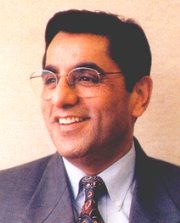 Site Selection: Congratulations on your recent promotion to Senior Vice President, Corporate Services. How does this change your role at Charles Schwab?
Site Selection: Congratulations on your recent promotion to Senior Vice President, Corporate Services. How does this change your role at Charles Schwab?
Parkash P. Ahuja: Thank you. As for my responsibilities, prior to this change I was responsible for corporate real estate facilities, purchasing, travel, food services and corporate records. I used to report to the chief administrative officer. Since the beginning of this year, I have taken additional responsibilities for accounts payable, payroll and technology — not in terms of our network, but the technology that increases employees’ productivity, [a set of systems] we call Infonet.
Also, I have started to report to the chief financial officer. My counterpart, the head of human resources, has also started to report to the CFO. Under the CFO, there is the traditional financial area, human resources, and the services I manage, which we call corporate services. Essentially, we have brought together finance, HR, corporate services and technology under one management [entity]. Reporting directly to the CFO gives me a seat on his staff, in senior management, for managing the corporate infrastructure.
SS: To what extent does this announcement reflect the company’s commitment to the CIR model?
 PPA: We have been talking about CIR ever since IDRC came up with the model. I did a lot of convincing within the organization that the model makes a lot of sense and that it met our infrastructural needs. In fact, even prior to this change, the responsibilities I had were a mini model of CIR, but we wanted to proceed with CIR full tilt.
PPA: We have been talking about CIR ever since IDRC came up with the model. I did a lot of convincing within the organization that the model makes a lot of sense and that it met our infrastructural needs. In fact, even prior to this change, the responsibilities I had were a mini model of CIR, but we wanted to proceed with CIR full tilt.
We as a corporation recognized that there are tremendous gains for the corporation and for the employees. All the services would be under one roof, we would be able to strategize about the extent and the quality of services in a more consolidated manner. There would be less confusion, and probably there are a lot of gains in terms of leveraging different services and departments.
SS: Some would say Charles Schwab is light years ahead of other companies in implementing CIR. What have been the key milestones along the way?
PPA: Schwab is a very fast-growing company. We are on the cutting edge of technology, and we are always concerned about using the latest techniques, technology and processes to bring our service levels to our customers in such a way that at a minimum we meet their expectations. But our goal is to exceed their expectations constantly. We are streamlining the internal processes so we can be more responsive to the external customers.
SS: Some corporate real estate executives are leery of the CIR model, because of turf battles they anticipate would ensue. Has that been an issue in your experience, and how can people get past that potential barrier?
PPA: If people are convinced it’s the right model, then they should work hard to convince their management and the people around them that it is the right model. Sometimes, it can be a tiring effort. But if they feel it is the right model, they must work on getting it implemented. I understand that in some cases it might take longer than other cases.
I am fortunate to work in a company that is very forward thinking and strategic. Management always embraces new ideas and is willing to take a risk if they think an idea makes sense. In some other cases, it may not be the same situation. But in those cases, people just have to work harder. Nothing comes easy. If you believe it is the right model, then convince people it is the right model.
SS: You have made the point in the past that integrating the corporate infrastructure offers the opportunity to (1) lower operating costs; (2) attract and retain quality employees; and (3) increase employee productivity. Could you expand on these points?
PPA: Yes. Our goal is to leverage the corporate infrastructure resources so that we can work together, the employees have a better career path and we can better see where things are falling through the cracks. To elaborate a little more, in all of the functions [I oversee], eventually we have a service that needs to be delivered to our employees or the end-users. In every single service, there is a delivery model. There will always be subject or functional experts. But if we can streamline the delivery models so that the services are delivered through one area, then all the questions are taken at one place and resolved. We already have made tremendous gains in terms of reducing the costs.
On the second point, by reducing the costs, hopefully we can elevate the service levels, provide better, cheaper and faster services to our employees on a constant basis. That puts pressure on us to improve processes constantly. But when the employees are happy, that helps us retain as well as attract new employees.
Increasing productivity is a big issue being debated within the corporation. We are very serious in terms of both embracing the technology and doing what our entity needs in order to provide better services, competitive benefits and compensation to our employees so we can keep them satisfied. Satisfied employees will have far greater productivity than unsatisfied employees will. It’s a very competitive environment. We are in a very strong economy. Most companies are doing quite well, and there is no shortage of qualified workers who want to work. In this environment, we need to keep our employees satisfied so that they consider Charles Schwab as one of the best places to work. If they are satisfied, productivity will improve.
SS: Integrating corporate infrastructure seems like a move toward centralizing corporate functions, reducing layers of management and so forth. At the same time, you have said elsewhere that you are eliminating the command and control system, replacing it with an environment characterized by self-management and teamwork, which seems to be a decentralization strategy. How are you reconciling these apparently competing forces?
PPA: Our business model is that we moving more and more towards self-help, so we can use technology for most of the processing. We are getting away from paper work, filling out paper forms. On one hand, we are involving the employees, but on the other, you are correct — we are trying to centralize functions. At our field locations, such as service centers and call centers, we have support employees, and they work under a corporate template. Our intent is to provide a minimum set of instructions and the processes and procedures so that they can change those processes and procedures based on the local demand or need. In other words, we provide them a minimum set of instructions about how a corporate process works, but if they need to amend it locally, then they are authorized to do that.
SS: How are you quantifying efforts to integrate Schwab’s internal infrastructure?
PPA: There are metrics in place within every unit of corporate infrastructure services. We try to measure people’s productivity and their satisfaction levels with customer service. We try to learn from that customer service feedback instead of just completing the service. And we try to figure out in terms of the satisfaction rating — what does it do to the voluntary termination, to absenteeism? That also gives us a good gauge of whether employees are satisfied and like the services we offer.
On a quarterly basis, we have focus group meetings, where we take feedback from employees. The company’s intranet offers people an opportunity to post anything on an anonymous basis, and people in this company are very vocal. If they don’t like something, they will immediately say so. Another effort is called “service enhancement.” Under that effort, we are working with the metrics and adapting various standard quality measures to meet today’s needs and our corporation’s needs.
SS: When the CIR model was first implemented, were there expectations or goals it was to achieve?
PPA: There were specific goals for decreasing costs and increasing employee satisfaction. These are contrary challenges, if you think about it. Usually, if you try to reduce costs, the service level will likely go down and people will be upset. Conversely, you make people very happy by providing whatever they want, but that of course escalates the cost. Keeping that balance has been a tough game, but we have been able to achieve that. Consolidating all of these services into corporate infrastructure resources will further help us achieve those goals.
SS: In what other areas should today’s corporate real estate executives be focusing their energies?
PPA: They need to think and act like a businessperson instead of just a real estate person. They need to get involved with their company’s business and understand their business. They must present themselves as an effective business partner who helps achieve business results instead of a partner who merely helps them achieve their space requirements. But it is up to the people within this function to decide how far they want to rise within the corporation. The door is definitely open. The opportunity is there. That is an important distinction.
SS: In your view, is senior management in the business world beginning to accept the notion of including the infrastructure manager or corporate real estate executive in on key business decisions?
PPA: There is a clear awakening going on in most of the corporations that these areas are important and that such executives should play a role in strategic planning. If corporate real estate professionals don’t rise to the occasion, someone else will manage them. The down side is there may be very little understanding or sympathy for this function. It’s up to individuals to present a polished view with a total business understanding versus just an understanding of real estate.
SS: Looking ahead three to five years, in what way will corporate real estate decision making be different than it is today?
PPA: In many companies, the way we work is entirely different today than the way we worked even a couple of years ago. Technology is playing a major role; most often, consensus takes place electronically instead of in a conference room. Decisions tend to be made fairly quickly. People are more inclined to make decisions on a factual basis instead of a sentimental basis. Even in terms of real estate, it’s dollars and cents and the functionality rather than one’s liking a certain location. There is less an element of personal bias and sentiment and more of a focus on financial considerations and business needs. In the future, this will be more the case.
What this will mean for the landlords and the real estate community is that they will have to come up with a value proposition. That’s the bottom line. People coming on board will have to say how their proposition adds value to what you are looking for, and it must be the best value in town.
SS
